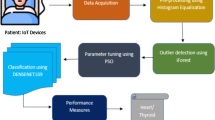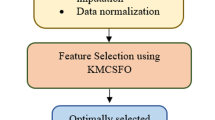Abstract
A number of strategies empowered by Internet of Thing (IoT) have been utilized for the prediction of several dreadful diseases like diabetic for which ceaseless and real-time tracing system is an exceptionally predominant one. Wearable medical devices with sensor have consistently producing abundant data volume referred to as big data. With higher speed of data creation, it becomes cumbersome to accumulate, operate and analyze such abundant data volume during emergency. Deep Learning (DL) approaches have been largely made use of perceiving patterns, categorizing objects and the prediction of diabetic diseases at an early stage. Even so, DLs are fundamentally modest in evaluation precisely when the diabetic disease data size is abundant. To achieve the expectations of DLs for big data applications from an electronic device, the evaluation procedure for diabetic disease prediction must be speeded up, so that early analysis can be arrived at. In this work, a method called Equidistant Heuristic and Duplex Deep Neural Network (EH-DDNN) for early diabetic disease prediction is proposed. First, with the Big Data dataset as input, Equidistant Heuristic Pruning (EHP) algorithm is presented for feature selection. The EHP splits the input data matrix into rows and columns separately. By utilizing the notion of conditional non-alignment assessment and heuristics techniques, EHP, exploits neighbourhood evaluations into sub-division while reducing the communication time and overhead, thus enormously correlating computations. This in turn removes the irrelevant as well as redundant features, therefore resulting with fewer features easier for early prediction. Next, with the inherent features, a Duplex Deep Neural Network (DDNN) is designed for early prediction analyses a fusion of nonlinear processing features and linear response for stockpiling abundant data volume. Experiments are conducted and validation is performed on the benchmark datasets, Diabetes Data Set from UCI repository and Pima Indians Diabetes Disease dataset. Comparative analysis of diabetic disease prediction time, diabetic disease prediction overhead and ROC curve analysis are made.







Similar content being viewed by others
References
Abbas HT, Alic L, Erraguntla M, Ji JX, Abdul-Ghani M, Abbasi QH, Qaraqe MK (2019) Predicting long-term type 2 diabetes with support vector machine using oral glucose tolerance test. PLOS One https://doi.org/https://doi.org/10.1371/journal.pone.0219636
Alam TM, Iqbal MA, Alia Y, Wahab A, Ijaz S, Baig TI, Hussain A, Malik MA, Raza MM, Ibrar S, Abbas Z (2019) A model for early prediction of diabetes. Inform Med Unlocked, Elsevier
Albers DJ, Levine M, Gluckman B, Ginsberg H, Hripcsak G, Mamykina L (2017) Personalized glucose forecasting for type 2 diabetes using data assimilation. PLOS Comput Biol https://doi.org/https://doi.org/10.1371/journal.pcbi.1005232
Alghamdi M, Al-Mallah M, Keteyian S, Brawner C, Ehrman J, Sakr S (2017) Predicting diabetes mellitus using SMOTE and ensemble machine learning approach: the Henry Ford ExercIse Testing (FIT) project. PLOS One | https://doi.org/https://doi.org/10.1371/journal.pone.0179805
Alloghani M, Aljaaf A, Hussain A, Baker T, Mustafina J, Al-Jumeily D, Khalaf M, Implementation of machine learning algorithms to create diabetic patient re-admission profiles. Med Inform Decision Making
Ayon SI, Islam MM (2019) Diabetes prediction: a deep learning approach. Int J Inform Eng Electron Business
BalaAnand Muthu, C. B. Sivaparthipan, Gunasekaran Manogaran, Revathi Sundarasekar, Seifedine Kadry, A. Shanthini, Antony Dase7, “IOT based wearable sensor for diseases prediction and symptom analysis in healthcare sector”, Peer-to-Peer Networking and Applications, Jan 2020 [Generalize Approximate Reasoning-based Intelligence Control (GARIC)]
Cola´s A, Vigil L, Vargas B, Cuesta–Frau D, Varela M (2019) Detrended Fluctuation Analysis in the prediction of type 2 diabetes mellitus in patients at risk: Model optimization and comparison with other metrics”, PLOS One | https://doi.org/https://doi.org/10.1371/journal.pone.0225817
Deepa N, Prabadevi B, Maddikunta PK, Gadekallu TR, Baker T, Khan MA, Tariq U (2020) An AI‑based intelligent system for healthcare analysis using, Ridge‑Adaline Stochastic Gradient Descent Classifier. J Supercomput, Springer
Ed-daoudy A, Maalmi K (2019) A new internet of things architecture for real‑time prediction of various diseases using machine learning on big data environment. J Big Data, Springer Open
Fiorini S, Hajati F, Barla A, Girosi F (2019) Predicting diabetes second-line therapy initiation in the Australian population via time span-guided neural attention network, PLOS One https://doi.org/https://doi.org/10.1371/journal.pone.0211844
Kaur H, Kumari V (2018) Predictive modelling and analytics for diabetes using a machine learning approach. Appl Comput Inform Elsevier
Kraege V, Vollenweider P, Waeber G, Sharp SJ, Vallejo M, Infante O, Mirjalili MR, Ezoddini-Ardakani F, Mozaffari-Khosravi H, Lotfi MH, Mirzaei M, Me´an M, Marques-Vidal P (2019) Development and multi-cohort validation of a clinical score for predicting type 2 diabetes mellitus. PLOS One https://doi.org/https://doi.org/10.1371/journal.pone.0218933
Li Y, Li H, Yao H (2018) Analysis and study of diabetes follow-up data using a data-mining-based approach in New Urban Area of Urumqi, Xinjiang, China, 2016–2017. Computational and Mathematical Methods in Medicine, Hindawi
Manikandan V, Yuvaraj N Advanced expert system using particle swarm optimization based adaptive network based fuzzy inference system to diagnose the physical constitution of human body. In: Emerging technologies in computer engineering: microservices in big data analytics: second international conference, ICETCE 2019, Jaipur, India, February 1–2, 2019, Revised Selected Papers. Vol. 985. Springer, 2019.
Merchant RM, Asch DA, Crutchley P, Ungar LH, Guntuku SC, Eichstaedt JC, Hill S, Padrez K, Smith RJ, Schwartz HA (2019) Evaluating the predictability of medical conditions from social media posts. PLOS One https://doi.org/https://doi.org/10.1371/journal.pone.0215476
Mhaskar HN, Pereverzyev SV, van der Walt MD (2017) A deep learning approach to diabetic blood glucose prediction. Front Appl Math Stat Volume 3 Article 14
Narmatha C et al. (2020) A hybrid fuzzy brain-storm optimization algorithm for the classification of brain tumor MRI images. J Ambient Intell Human Comput (2020): 1–9.
Naz H, Ahuja S Deep learning approach for diabetes prediction using PIMA Indian dataset. Journal of Diabetes & Metabolic Disorders, Springer, Mar 2020 [diverse machine learning algorithm]
Riazul Islam SM, Kwak D, Kabir MH, Hossain M, Kyung-Supkwak (2015) The internet of things for health care: a comprehensive survey , IEEE Access, 3
Saranya P, Prabakaran S (2020) Automatic detection of non-proliferative diabetic retinopathy in retinal fundus images using convolution neural network. J Ambient Intell Human Comput. https://doi.org/10.1007/s12652-020-02518-6
Sneha N, Gangil T (2019) Analysis of diabetes mellitus for early prediction using optimal features selection. J Big Data, Springer
Tsamardinos I, Borboudakis G, Katsogridakis P, Pratikakis P, Christophides V (2019) A greedy feature selection algorithm for big data of high dimensionality. Machine Learning, Springer, Berlin
Acknowledgements
The authors extend their appreciation to the Deputyship for Research & Innovation, Ministry of Education in Saudi Arabia for funding this research through project number—PNU-DRI-RI-20-005.
Author information
Authors and Affiliations
Corresponding author
Additional information
Publisher's Note
Springer Nature remains neutral with regard to jurisdictional claims in published maps and institutional affiliations.
Rights and permissions
About this article
Cite this article
Sivakumar, N.R., Karim, F.K.D. An IoT based big data framework using equidistant heuristic and duplex deep neural network for diabetic disease prediction. J Ambient Intell Human Comput (2021). https://doi.org/10.1007/s12652-021-03014-1
Received:
Accepted:
Published:
DOI: https://doi.org/10.1007/s12652-021-03014-1




